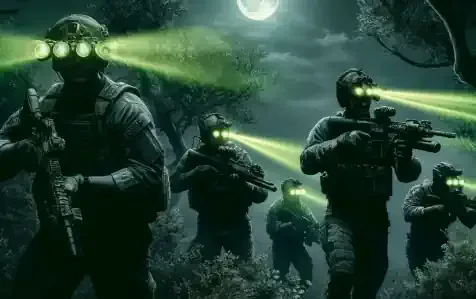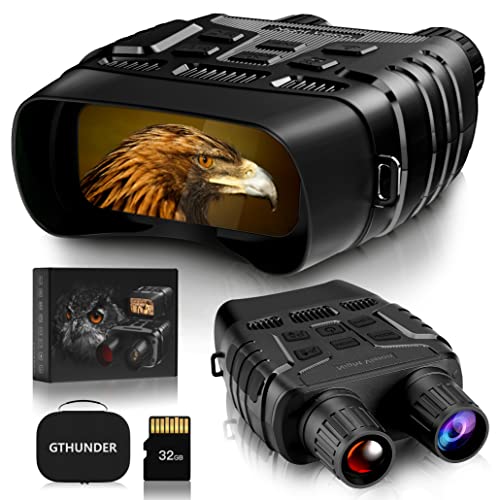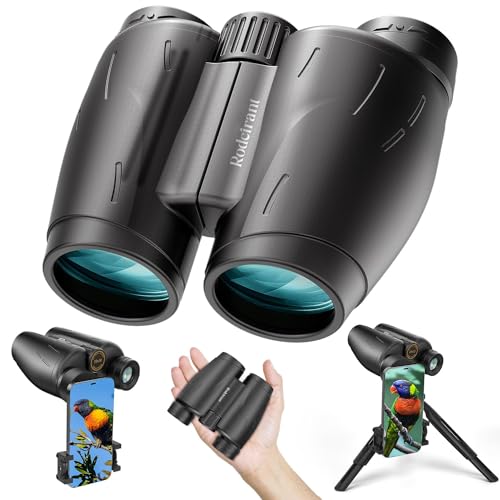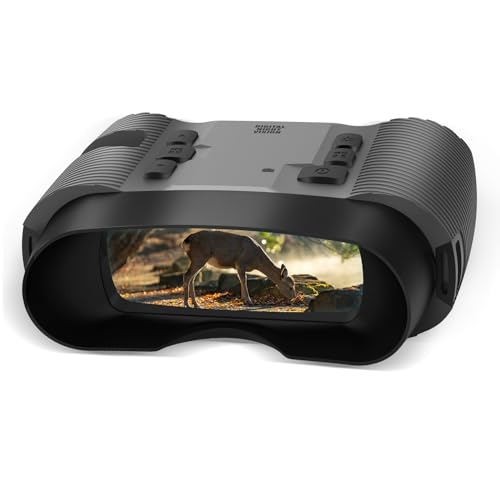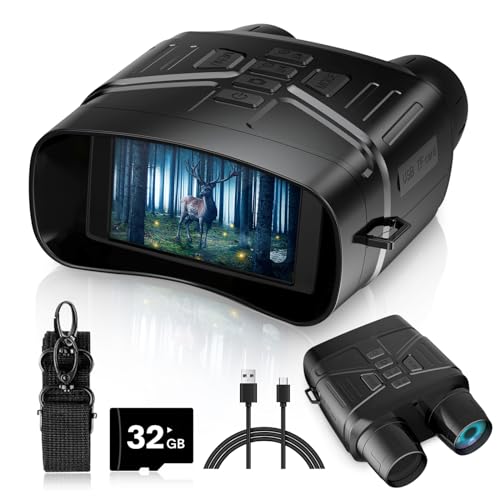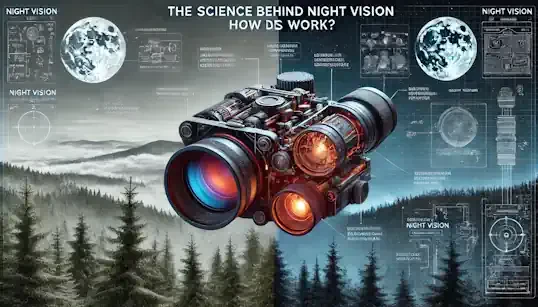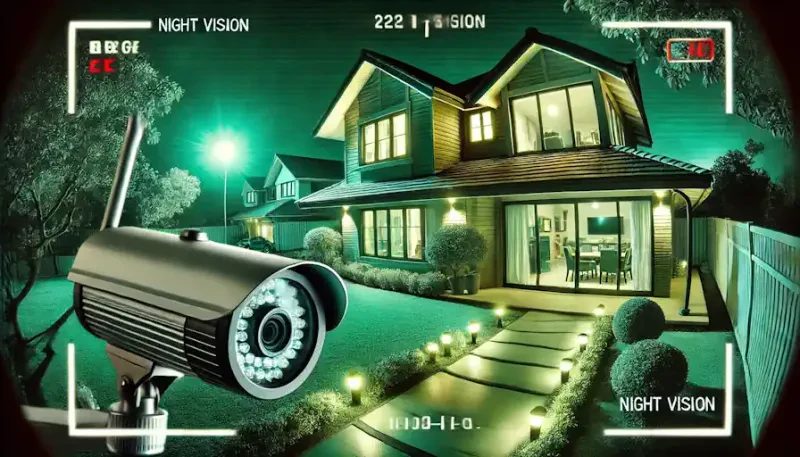The World Of Night Vision
The ability to see in the dark, once a realm relegated to science fiction, has become a reality thanks to the development of night vision technology. This remarkable innovation has not only revolutionized military operations but also found its way into various aspects of our lives, from wildlife observation to home security. In this comprehensive exploration, we'll journey through the history, science, and impact of night vision, uncovering its transformative power.
The Essence Of Night Vision Technology
At its core, night vision technology allows us to perceive the world around us even when natural light is scarce or absent. It achieves this by amplifying existing light, detecting infrared radiation (heat), or utilizing other specialized methods. Whether it's soldiers navigating a battlefield or homeowners monitoring their property at night, night vision provides an invaluable advantage by extending our vision beyond the limitations of daylight.
A Brief Overview Of Night Vision's Impact
The impact of night vision technology on our world cannot be overstated. It has redefined military tactics, empowered law enforcement agencies, and opened up new avenues for scientific research and exploration. Moreover, it has found its way into consumer markets, offering everyday individuals the ability to experience the world in a whole new light – or lack thereof. From capturing stunning wildlife footage to enhancing home security, night vision has become an integral part of modern life.
From Battlefield To Backyard: The Expanding Reach Of Night Vision
The evolution of night vision technology has been remarkable, transitioning from bulky military equipment to compact, user-friendly devices. This accessibility has fueled its adoption in diverse fields, ranging from search and rescue operations to recreational activities like stargazing. As the technology continues to advance, its potential applications seem boundless, promising to illuminate even more aspects of our lives in the years to come.
Early Roots: The Genesis Of Night Vision In Warfare
While the concept of seeing in the dark has captivated human imagination for centuries, the practical development of night vision technology emerged from the crucible of warfare. The need to gain a tactical advantage under the cover of darkness spurred significant advancements, forever altering the landscape of military operations.
World War II: The Birthplace Of Military Night Vision
The Second World War served as the catalyst for the rapid development and deployment of night vision technology. As battles raged into the night, the ability to detect and engage enemy forces under the cloak of darkness became a critical factor in determining victory. Germany, in particular, recognized the potential of this emerging technology and invested heavily in research and development. Early night vision devices, often referred to as "Generation 0," were introduced during this period, enabling soldiers to see in low-light conditions using infrared illumination.
The Pivotal Role Of Infrared In Early Devices
The heart of early night vision devices lay in their utilization of infrared radiation, a form of electromagnetic radiation invisible to the human eye but emitted by warm objects. Generation 0 devices, also known as "sniperscopes" or "snooperscopes," were equipped with infrared illuminators that projected a beam of invisible light. This light would bounce off objects in the field of view and be captured by a specialized scope, which then converted the infrared signal into a visible image. While these early devices were bulky and limited in range, they provided a groundbreaking advantage in nighttime combat.
From Bulky Scopes To Handheld Goggles: Evolution In Action
As the war progressed, the demand for more portable and user-friendly night vision devices grew. This led to the development of Generation 1 night vision goggles, which featured improved image intensification technology. Image intensification involves amplifying existing light rather than relying solely on infrared illumination. These goggles offered a wider field of view and greater mobility, allowing soldiers to move more freely and effectively in low-light environments. While still relatively cumbersome by today's standards, these early goggles laid the foundation for the continued evolution of night vision technology.
The Cold War Era: Night Vision's Technological Leap
The cessation of World War II did not signal a pause in the advancement of night vision technology. Instead, the onset of the Cold War ushered in an era of intense technological rivalry between the United States and the Soviet Union, with each superpower vying to outdo the other in military capabilities. This geopolitical tension fueled a rapid acceleration in night vision research and development, leading to significant breakthroughs that would forever transform the landscape of warfare and surveillance.
The Race For Superiority: US Vs. USSR
The Cold War was not only a political and ideological struggle but also a technological arms race. Both the United States and the Soviet Union poured vast resources into developing cutting-edge military technologies, including night vision. Each side sought to equip their forces with the latest and most advanced tools to gain a tactical edge over their adversaries. This intense competition spurred a relentless cycle of innovation, pushing the boundaries of what was possible in the realm of night vision.
Advancements In Image Intensification
One of the most significant breakthroughs during this era was the refinement of image intensification technology. Second-generation image intensifiers, introduced in the 1960s, were significantly more compact and efficient than their predecessors. They utilized a microchannel plate, a thin wafer containing millions of tiny channels that amplified electrons and enhanced image brightness. This resulted in clearer, sharper images with reduced noise, making night vision devices more effective in low-light conditions.
New Applications Beyond The Battlefield: Surveillance And Espionage
As night vision technology matured, its potential applications extended far beyond the battlefield. Both the US and the USSR recognized the value of night vision in surveillance and espionage activities. Spy agencies on both sides utilized night vision devices to monitor enemy movements, conduct covert operations, and gather intelligence under the cover of darkness. The ability to see and record events invisible to the naked eye provided a significant advantage in the shadowy world of intelligence gathering.
Moreover, the development of thermal imaging technology during the Cold War era opened up new possibilities for night vision applications. Thermal imaging detects the infrared radiation emitted by objects, allowing users to see heat signatures rather than visible light. This proved invaluable for detecting hidden personnel, vehicles, and other objects, even in complete darkness or through obscurants like fog or smoke.
The Cold War may have been a time of global tension, but it also served as a fertile ground for technological innovation. The relentless pursuit of military superiority drove the rapid advancement of night vision technology, leading to a quantum leap in capabilities. These advancements not only transformed the nature of warfare but also paved the way for diverse applications in surveillance, espionage, and beyond. The legacy of the Cold War continues to influence the development and utilization of night vision technology to this day, as we continue to explore the possibilities of seeing in the dark.
Modern Advancements: The Digital Age Of Night Vision
The dawn of the 21st century ushered in a new era for night vision technology, marked by rapid advancements in digital imaging, sensor technology, and miniaturization. The transition from analog to digital systems revolutionized night vision capabilities, bringing about significant improvements in image quality, versatility, and accessibility. This digital transformation propelled night vision beyond its military origins, opening up new frontiers in civilian applications and expanding its impact on society as a whole.
Thermal Imaging: Seeing Heat Signatures In The Dark
Thermal imaging, which was initially developed during the Cold War era, has emerged as a cornerstone of modern night vision technology. Unlike image intensification, which relies on amplifying existing light, thermal imaging detects the infrared radiation emitted by objects based on their temperature differences. This enables users to "see" heat signatures in the dark, revealing the presence of people, animals, and objects even in complete darkness or through obscuring elements like fog, smoke, or foliage. Thermal imaging devices have become indispensable tools for firefighters, law enforcement officers, search and rescue teams, and wildlife enthusiasts, offering unparalleled visibility in challenging environments.
The Rise Of Digital Night Vision Sensors
The advent of digital image sensors revolutionized the field of night vision. Digital sensors, unlike their analog counterparts, convert light into electronic signals that can be processed and enhanced by computer algorithms. This digital processing allows for greater control over image quality, enabling features like automatic gain control, noise reduction, and image stabilization. Digital night vision devices also offer greater flexibility, as they can be easily integrated with other technologies such as GPS, laser rangefinders, and wireless communication systems. This integration has led to the development of sophisticated night vision systems that provide users with a wealth of information beyond just visual imagery.
Integration With Other Technologies: Augmented Reality And More
The digital nature of modern night vision technology has paved the way for its seamless integration with other cutting-edge technologies. One such integration is with augmented reality (AR), which overlays digital information onto the user's real-world view. In the context of night vision, this means that users can see critical information such as distance to target, compass headings, or even real-time threat assessments directly within their field of view. This integration enhances situational awareness and decision-making capabilities, making night vision devices even more valuable for military, law enforcement, and civilian applications.
Moreover, advancements in artificial intelligence (AI) and machine learning have the potential to further revolutionize night vision technology. AI algorithms can be trained to recognize and identify objects, track movements, and even predict potential threats, all in real-time. This could lead to the development of autonomous night vision systems that can alert users to potential dangers or provide valuable insights without requiring constant human supervision.
The digital age has ushered in a new era of innovation for night vision technology. With advancements in thermal imaging, digital sensors, and integration with other cutting-edge technologies, night vision has become more powerful, versatile, and accessible than ever before. The potential applications of this technology continue to expand, from military and law enforcement to scientific research, wildlife observation, and even everyday consumer use. As we continue to explore the possibilities of seeing in the dark, the future of night vision technology appears brighter than ever.
Night Vision Goes Mainstream: Beyond Military Applications
While night vision technology owes its genesis to military necessity, its evolution has transcended the battlefield, permeating various sectors of society. As advancements in design, miniaturization, and affordability took hold, night vision devices gradually made their way into the hands of law enforcement agencies, security professionals, wildlife enthusiasts, and even everyday consumers. This widespread adoption has not only diversified the applications of night vision but also democratized access to a technology once reserved for specialized use.
The Emergence Of Consumer Night Vision Products
The turn of the 21st century witnessed a significant shift in the availability and accessibility of night vision technology. Manufacturers began producing night vision devices specifically tailored for the consumer market, with a focus on affordability, ease of use, and versatility. This led to the emergence of a wide array of consumer-grade night vision products, including binoculars, monoculars, goggles, and even smartphone attachments. These devices, often equipped with digital sensors and user-friendly interfaces, enabled everyday individuals to explore the nocturnal world, observe wildlife, and enhance their personal security.
Applications In Law Enforcement And Security
Law enforcement agencies and security professionals were among the early adopters of night vision technology outside the military sphere. Night vision devices proved invaluable for surveillance operations, suspect tracking, and evidence collection under low-light conditions. SWAT teams and tactical units utilized night vision goggles to gain a tactical advantage during nighttime raids and hostage rescue missions. Security personnel employed night vision cameras to monitor critical infrastructure, deter criminal activity, and safeguard public safety. The integration of night vision with thermal imaging further expanded its utility in law enforcement, allowing for the detection of concealed individuals, tracking suspects through obscured terrain, and even identifying heat signatures left behind by fleeing vehicles.
Wildlife Observation And Nature Photography: A New Perspective
The advent of consumer-grade night vision devices opened up exciting possibilities for wildlife enthusiasts and nature photographers. Traditional wildlife observation and photography were often limited to daylight hours, leaving a vast realm of nocturnal animal behavior unexplored. Night vision binoculars and monoculars allowed enthusiasts to witness the hidden world of nocturnal creatures, observing their behaviors, interactions, and movements under the cover of darkness. Wildlife photographers were able to capture stunning images and videos of elusive nocturnal species, shedding light on their lives and contributing to scientific research and conservation efforts.
Beyond wildlife observation, night vision found applications in various outdoor activities such as camping, hiking, and boating. Night vision devices enhanced safety and navigation in low-light conditions, enabling outdoor enthusiasts to venture into the wilderness with greater confidence and preparedness.
The transition of night vision technology from military exclusivity to mainstream adoption has been a remarkable journey. The emergence of consumer-grade devices, coupled with diverse applications in law enforcement, security, and wildlife observation, has democratized access to this powerful tool. The ability to see in the dark, once a privilege reserved for a select few, has become a reality for a wide range of individuals, enriching their experiences and expanding their understanding of the world around them.
The Science Behind Night Vision: How It Works
While night vision technology may seem like magic to the uninitiated, it operates on well-established scientific principles that enable us to perceive the world in the absence of visible light. Understanding these principles is key to appreciating the ingenuity behind night vision devices and the potential they hold for future advancements.
Image Intensification: Amplifying Existing Light
At the heart of many night vision devices lies the process of image intensification. This technology works by taking the tiny amounts of ambient light available – whether from starlight, moonlight, or even distant streetlights – and amplifying it to a level visible to the human eye. This amplification is achieved through a series of steps, beginning with a photocathode that converts incoming photons into electrons. These electrons are then accelerated through a microchannel plate, multiplying their numbers and creating a stronger signal. Finally, a phosphor screen converts the amplified electrons back into photons, producing a visible image that is significantly brighter than the original scene.
Thermal Imaging: Detecting Heat Differences
Thermal imaging takes a different approach to night vision, relying on the detection of infrared radiation, or heat, emitted by objects. All objects with a temperature above absolute zero emit infrared radiation, and the intensity of this radiation varies depending on the object's temperature. Thermal imaging cameras capture this infrared radiation and convert it into a visual representation, where different temperatures are displayed as varying colors or shades. This allows users to see the heat signatures of objects, even in complete darkness or through obscuring elements like fog or smoke.
The Role Of Infrared Illumination
While some night vision devices, like thermal imagers, rely solely on naturally occurring infrared radiation, others employ active infrared illumination to enhance visibility in low-light conditions. Infrared illuminators emit a beam of near-infrared light, which is invisible to the human eye but can be detected by night vision devices equipped with image intensifiers. This infrared illumination illuminates the scene, allowing for clearer and brighter images in situations where ambient light is extremely limited.
Understanding The Technology Behind Digital Night Vision Sensors
The emergence of digital night vision sensors has revolutionized the field, offering several advantages over traditional analog systems. Digital sensors convert incoming light into electronic signals that can be processed and manipulated using sophisticated algorithms. This digital processing allows for greater control over image quality, enabling features like automatic gain control, noise reduction, and image stabilization. Additionally, digital night vision devices can be easily integrated with other technologies, such as GPS, laser rangefinders, and wireless communication systems, creating versatile and powerful tools for a wide range of applications.
The science behind night vision is a fascinating blend of physics, optics, and electronics. By understanding the principles of image intensification, thermal imaging, infrared illumination, and digital sensors, we can appreciate the remarkable capabilities of night vision technology and the potential it holds for future advancements.
The Future of Night Vision: What's on the Horizon
As with any technology, the trajectory of night vision is constantly evolving. The strides made in recent years promise not only to redefine how we perceive the world in low-light conditions but also to expand the potential applications of this transformative technology in ways we may not yet fully grasp. Let's delve into the exciting possibilities that lie ahead.
The Pursuit Of Smaller, More Affordable Devices
Miniaturization has been a consistent theme in the development of night vision technology. Early night vision devices were bulky and cumbersome, but advancements in electronics and optics have led to increasingly compact and lightweight models. This trend is expected to continue, with researchers and engineers striving to create night vision devices that are not only smaller but also more energy-efficient. This will make them more practical for everyday use, allowing individuals to carry them with ease and integrate them into various activities, from camping and hiking to nighttime photography and security applications.
In parallel with miniaturization, the affordability of night vision devices is also on the rise. As production costs decrease and competition increases, consumers can expect to see a wider range of night vision products at more accessible price points. This will further democratize access to night vision technology, enabling more people to experience the benefits of enhanced vision in low-light conditions.
Advancements In Image Quality And Range
Image quality has always been a critical factor in the effectiveness of night vision devices. Early generations of night vision technology often produced grainy, low-resolution images with limited color information. However, recent advancements in sensor technology, image processing algorithms, and optics have resulted in significant improvements in image clarity, resolution, and color fidelity. This translates to a more natural and immersive viewing experience, allowing users to see fine details and subtle nuances in low-light environments.
In addition to image quality, the range of night vision devices is also expanding. While traditional night vision technology was limited by the amount of available ambient light, advancements in thermal imaging and active infrared illumination have extended the effective range of night vision devices. This enables users to see farther into the distance, even in complete darkness, opening up new possibilities for applications such as long-range surveillance, search and rescue operations, and wildlife observation in remote areas.
Potential Applications In Healthcare And Automotive Industries
Beyond its traditional applications in military, law enforcement, and consumer markets, night vision technology holds promising potential in diverse fields such as healthcare and the automotive industry. In healthcare, night vision devices could assist surgeons during minimally invasive procedures, allowing them to visualize internal structures with greater clarity and precision. Night vision could also aid in diagnosing certain medical conditions, such as eye diseases or circulatory problems, by enabling visualization of blood vessels and other anatomical structures under low-light conditions.
In the automotive industry, night vision technology is already being integrated into high-end vehicles to enhance driver safety. Night vision systems use thermal imaging or near-infrared illumination to detect pedestrians, animals, and other obstacles on the road that may not be visible to the naked eye. This information is then displayed on the vehicle's dashboard or heads-up display, giving drivers an early warning and allowing them to react in time to avoid collisions. As night vision technology becomes more affordable and accessible, it is expected to become a standard feature in a wider range of vehicles, contributing to safer roads and reduced accidents.
Ethical Considerations And Challenges: The Darker Side Of Night Vision
While night vision technology has undoubtedly revolutionized various aspects of human activity, its proliferation has also raised a host of ethical considerations and challenges. As with any powerful tool, the potential for misuse or unintended consequences looms large. It is imperative to critically examine these concerns to ensure that the benefits of night vision are harnessed responsibly and that its potential for harm is mitigated.
Privacy Concerns In The Age Of Surveillance
One of the most pressing ethical concerns surrounding night vision technology is its impact on privacy. The ability to see in the dark has the potential to erode the traditional boundaries between public and private spaces. As night vision devices become more affordable and readily available, the risk of unauthorized surveillance, voyeurism, and invasion of privacy increases. This raises questions about the balance between security and individual freedoms, and the need for robust regulations to protect against potential abuses.
Furthermore, the rise of government surveillance programs that utilize night vision technology has sparked debates about the extent to which authorities should be allowed to monitor citizens without their knowledge or consent. The use of night vision-equipped drones and cameras in public spaces raises concerns about mass surveillance and the potential for abuse of power. Striking the right balance between security needs and individual privacy rights is a complex challenge that requires careful consideration and ongoing dialogue.
The Potential For Misuse Of Night Vision Technology
Beyond privacy concerns, the potential for misuse of night vision technology in criminal activities is a significant concern. Night vision devices can be used for illegal hunting, poaching, theft, and other nefarious purposes. The anonymity afforded by darkness, coupled with the enhanced vision provided by night vision, can embolden individuals to engage in activities they might otherwise avoid in daylight. This poses challenges for law enforcement agencies, who must adapt their tactics and strategies to counter the use of night vision by criminals.
Additionally, the proliferation of night vision technology could lead to an escalation in asymmetric warfare and terrorist activities. Non-state actors and terrorist groups could exploit night vision to carry out attacks under the cover of darkness, potentially causing significant harm and destabilizing societies. This underscores the need for international cooperation and regulation to prevent the proliferation of night vision technology into the wrong hands.
Regulations And Restrictions: Balancing Security And Freedom
The ethical challenges posed by night vision technology necessitate the development of robust regulations and restrictions to mitigate potential harm. Governments, international organizations, and industry leaders must work together to establish clear guidelines on the use of night vision, ensuring that it is employed responsibly and ethically.
One approach is to restrict the sale and distribution of certain types of night vision devices to authorized personnel, such as law enforcement officers, military personnel, and licensed security professionals. This would help prevent the proliferation of powerful night vision technology into the hands of those who might misuse it. Additionally, regulations could be implemented to control the use of night vision in public spaces, ensuring that it is not used for unauthorized surveillance or other invasive purposes.
However, it is important to strike a balance between security concerns and individual freedoms. Overly restrictive regulations could stifle innovation and limit the legitimate uses of night vision technology. It is crucial to foster an open dialogue among stakeholders, including policymakers, industry representatives, privacy advocates, and civil society groups, to develop regulations that are both effective and respectful of individual rights.
The ethical considerations and challenges associated with night vision technology are complex and multifaceted. As this technology continues to advance and become more widely available, it is essential to engage in ongoing discussions about its responsible use and the potential consequences of its misuse. By addressing these concerns proactively, we can ensure that night vision technology serves as a tool for good, enhancing safety, security, and our understanding of the world around us, while minimizing the potential for harm.
Night Vision's Enduring Impact And Future Potential
The journey of night vision technology, from its wartime origins to its widespread adoption in modern society, is a testament to human ingenuity and the relentless pursuit of innovation. It is a story of how a tool initially designed for military advantage transformed into a versatile instrument with applications spanning diverse fields, from law enforcement and security to wildlife observation and personal recreation. As we look back at the remarkable evolution of night vision, it is clear that its impact has been far-reaching and transformative.
Reflecting On Night Vision's Transformative Journey
The development of night vision technology has not only expanded our ability to perceive the world around us but also reshaped our understanding of the nocturnal realm. It has allowed us to witness the secret lives of animals, explore hidden landscapes, and navigate challenging environments with newfound confidence. From the battlefields of World War II to the bustling city streets of today, night vision has become an integral part of our lives, enhancing our safety, security, and understanding of the world after dark.
Moreover, night vision technology has played a crucial role in scientific research and exploration. It has enabled astronomers to peer deeper into the cosmos, revealing celestial objects and phenomena that would otherwise remain hidden. Biologists have utilized night vision to study the behavior of nocturnal animals in their natural habitats, gaining valuable insights into their ecology and evolution. And archaeologists have employed night vision to uncover hidden archaeological sites and artifacts, shedding light on the past and enriching our understanding of human history.
The Unforeseen Consequences Of A Military Innovation
The trajectory of night vision technology serves as a reminder that even the most specialized military innovations can have far-reaching and unforeseen consequences. What began as a tool for gaining a tactical advantage in warfare has evolved into a technology that touches countless aspects of our lives. The democratization of night vision, fueled by advancements in miniaturization, affordability, and ease of use, has opened up new possibilities for individuals and communities to explore, learn, and interact with the world in ways that were previously unimaginable.
However, the widespread adoption of night vision also raises important ethical questions and challenges. As discussed in the previous section, the potential for misuse, privacy concerns, and the need for responsible regulation are all critical issues that must be addressed as night vision technology continues to evolve. It is crucial to strike a balance between harnessing the benefits of this powerful tool and mitigating its potential for harm, ensuring that it serves the greater good of society.
Looking Ahead: A World Illuminated By Night Vision
The future of night vision technology holds immense promise. Ongoing research and development are focused on creating even smaller, more powerful, and more affordable devices that can be integrated into a wide range of applications. Advancements in image quality, range, and functionality are expected to further enhance the user experience and expand the capabilities of night vision technology. We can anticipate the emergence of new applications in fields as diverse as healthcare, transportation, environmental monitoring, and disaster response.
As night vision technology becomes increasingly ubiquitous, it will undoubtedly continue to transform our world in ways we have yet to fully comprehend. It has the potential to redefine how we interact with our environment, enhance our safety and security, and unlock new discoveries and insights. By embracing the possibilities and addressing the challenges, we can ensure that night vision technology continues to illuminate our path towards a brighter future.
